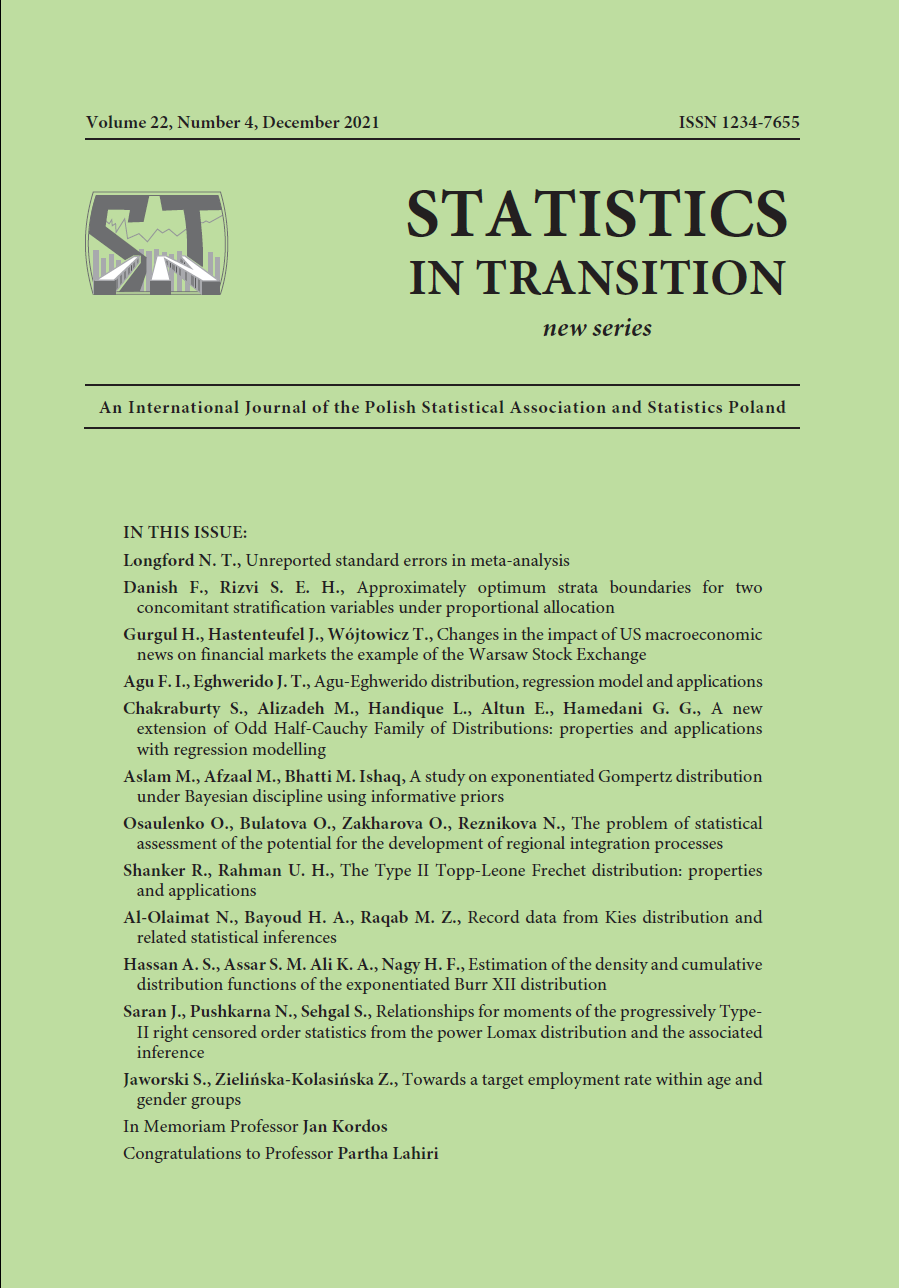ARTICLE
ABSTRACT
Quarterly employment rates in European countries are analysed in terms of the likelihood of achieving a specific employment rate within age and gender groups in a five-year horizon. The German employment rate serves as a benchmark for this research. The likelihood is estimated by a Monte-Carlo simulation based on the class of exponential smoothing models. The research presents a pessimistic prognosis of employment rates in European countries with respect to young and partly to older workers.
KEYWORDS
employment rate, exponential smoothing, forecasting, state space approach
REFERENCES
Baumol, W. J., (2015). Macroeconomics: Principles and policy, Cengage Learning, Inc.
Bell, D. N., Blanchflower, D. G., (2011). Young people and the Greater Recession,Oxford Review of Economic Policy, Vol 27 (2), pp. 241–267.
Cléaud, G., De Castro Fernández, F., Durán Laguna, J., Granelli, L., Hallet, M., Jaubertie, A., Maravall Rodriguez, C., Ognyanova, D., Palvolgyi, B., Tsalinski, T., Weißschädel, K., Ziemendorff, J., (2019). Cruising at different speeds: similarities and divergences between the German and the French economies, European Commission.
Directorate General for Economic and Financial Affairs, Discussion Paper 103. https://doi.org/10.2765/756955
Corselli-Nordblad, L., Strandell, H., (2020). Ageing Europe: Looking at the lives of older people in the EU: 2020 Edition, Eurostat. https://doi.org/10.2785/628105.
Dustmann, Ch., Eichengreen, B., Otten, S., Sapir, A., Tabellini, G., Zoega, G., (2017). Europe’s trust deficit: Causes and remedies, CEPRR PRESS. Retrieved from http://voxeu.org/system/files/epublication/Europes_Trust_Deficit_MII1.pdf
European Commission, (2020). European Skills Agenda for Sustainable Competitiveness, Social Fairness and Resilience, Retrieved from https://ec.europa.eu/social/main.jsp?catId=89&newsId=9723
European Commission, (2018). The Youth Guarantee. Retrieved from https://ec.europa.eu/social/main.jsp?catId=1079
European Commission, (2017). Investing in Europe’s Youth. Retrieved from https://ec.europa.eu/social/BlobServlet?docId=16923.
European Commission, (2012). Youth Employment Initiative. Retrieved from https://ec.europa.eu/social/main.jsp?catId=1176.
Hartung, B., Jung, P., Kuhn, M., (2018). What hides behind the German labour market miracle? Unemployment insurance reforms and labor market dynamics, CESifoWorking Paper Series 7379. Retrieved from https://ideas.repec.org/p/ces/ceswps/_7379.html
Herzog-Stein, A., Lindner, F., Sturn, S., (2013). Explaining the German employment miracle in the Great Recession – The crucial role of temporary working time reductions, IMK Working Paper 114–2013, IMK at the Hans Boeckler Foundation, Macroeconomic Policy Institute. Retrieved from http://www.boeckler.de/pdf/p_imk_wp_114_2013.pdf
Hyndman R. J., Koehler, A. B., Snyder, R., D., Grose, S., (2002). A state space framework for automatic forecasting using exponential smoothing methods, International Journal of Forecasting, 18(3), pp. 439–454.
Hyndman R., J., Koehler, A., B., Ord, J., K., Snyder, R., D., (2005). Prediction intervals for exponential smoothing using two new classes of state space models, Journal of Forecasting, 24, pp. 17–37.
Hyndman R., Khadakar, Y., (2008a). Automatic time series forecasting: The forecast package for R, Journal of Statistical Software, 27(3).
Hyndman R., J., Koehler, A. B., Ord, J. K., Snyder, R. D., (2008b). Forecasting with exponential smoothing – the state space approach, Springer-Verlag Berlin Heidelberg.
Le Bon, G., (2015). The Crowd and The Psychology of Revolution, CreateSpace Independent Publishing Platform.
Matthews, P., Besemer, K., (2014). Poverty and social networks evidence review, Joseph Rowntree Foundation. Retrieved from http://www.storre.stir.ac.uk/bitstream/1893/ 21042/1/JRF%20final%20published%20report.pdf.
Möller, J., (2010). The German labour market response in the World Recession – de-mystifying a miracle, Zeitschrift Für ArbeitsmarktForschung, 42(4), 325–336. https://doi.org/10.1007/s12651-009-0026-6
Ord, J. K., Koehler, A. B., Snyder, R. D., (1997). Estimation and prediction for a class of dynamic nonlinear statistical models, Journal of the American Statistical Association, 92, pp. 1621–1629.
Standing, G., (2016). The Precariat: The new dangerous class, London, UK and New York, USA: Bloomsbury Academic.
van den Berg, T., Elders, L., de Zwart, B., Burdorf, A., (2008). The effects of work-related and individual factors on the Work Ability Index: A systematic review, Occupational and Environmental Medicine, 66(4), pp. 211–220.
Van Rijn R. M, Robroek S. J. , Brouwer, S. Burdorf, A., (2014). Influence of poor health on exit from paid employment: A systematic review, Occupational and Environmental Medicine, 71(4), pp. 295–301.
